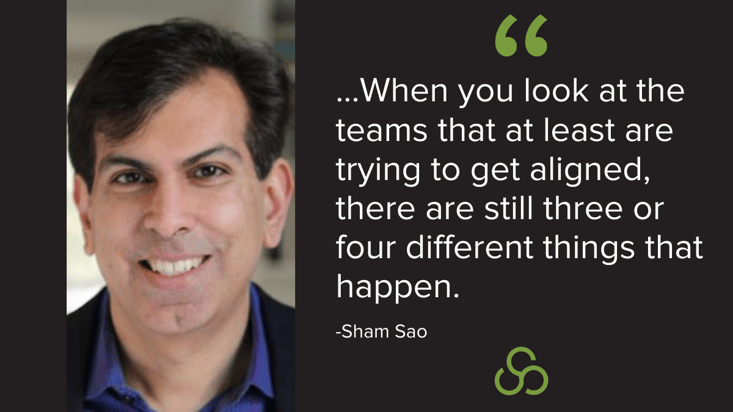
We know that getting the perfect alignment between sales and marketing isn't always easy but once you find the perfect middle ground, the results speak for themselves.
So what are the biggest things Sham Sao has seen that create misalignment between sales and marketing?
Find out in this clip from the What Sales Can Learn From Series.
Carole Mahoney:
So what are some of the reasons or things that you've seen that create this misalignment? If there's so much benefit to it, why are we still struggling to get there?
Sham Sao:
Yeah, absolutely. Well, there's one cause that I'm starting to see dissipate a little bit, which I'm glad and that one, is that the teams never really try to get aligned to begin with, right? That does still happen to some degree, but thankfully I would say that's happening less and most teams say, "Okay, we do need to work together," and they at least try to get aligned, right?
So when you look at the teams that at least are trying to get aligned, there are still three or four different things that happen. The first one is what I would call "The Devil's in the Details" and by that I would mean that yeah, they're aligned at the high level, right? So the market definition, maybe it's the same vertical they've agreed upon or same high level market segmentation, but they're not aligned at the next level down.
So when you talk about what specific pain points or attributes do you need to see from a customer for it to be a good fit, they might not really have even talked about it or written it down. So that's the first thing is they just haven't gone down deep enough. They're sort of at the surface level of alignment.
The next one is really what happens when, say they've gotten alignment, where I see misalignment start to happen is when an organization gets really pushed to drive accelerated growth. And what happens here is marketing ends up trying to generate new sources of leads from places that it has not tapped before. And then what happens is, either those leads aren't the same quality, because it's pretty hard when you're going after new lead sources to make sure that they're exactly uniformly the same quality as what you've been doing before and you're trying new stuff. It's pretty hard. It's not going to happen all the time.
So there's got to be alignment to see, okay, which ones are good, which ones are not good, we want to get the feedback, we want to adjust. The other is, even if they lead to the same quality, but they might be a slightly different value prop that was emphasized from what you were looking at before, the way you follow up on those might need to be slightly different and if we don't, then there's going to feel like there's misalignment.
And in both of these instances, what happens is sales just feels like the leads are junk, right? It feels like the numbers are going up, but it's junk, and as soon as you have sales start to feel like the marketing leads are junk, that's where everything breaks down. So you've got to stop and come back and say, "Okay, why are they junk? What's happening? Is it all, is it some, is it because we're just not used to these?" And then tackle it from there, right?
Carole Mahoney:
Yeah, so it sounds like not just at a high level, okay, we're aligned in these value propositions, but then also even bringing that down into writing it down, putting the details to it, but then also being able to be timely with that because like you said, if marketing is doing A/B testing, there's going to be some very frequent touch points with sales as that campaign's rolling out to see how it's going and how it's working. So we're not just talking once a month meetings, we're talking weekly, if not more, it sounds like.
Sham Sao:
Yeah, absolutely, and I'll go into this more, but I've typically had at least weekly. And I've actually found it valuable to have it twice, but once where sales is running it and once where marketing is running it so they can both bring their own stuff to the table and we can talk a little bit more about that. I know we're going to get into more about how you stay aligned.
There's one more thing on this topic around misalignment that comes up and that's also when the strategy evolves or changes. The meetings help with all these things because what happens is if you're growing and you have new sources of leads, if there's not good willingness to talk, then there's just this shutdown of the marketing leads, they're junk. But if the teams are talking, you can say, "Okay, which leads are bad and why?" Right?
Same thing, if the strategy starts to change, if you start to expand after a new market segment. There's going to be some things that are different and the teams just need to look at how those are working and how they're different from what they've been used to and how they can adapt.
Carole Mahoney:
It's almost as if the strategy needs to include, "All right, here's what we want it to look like and here's what we're going to do if it all blows up." Because a lot of times we see strategies where ideally, this is what we're going to do and ideally this is what's going to happen but in reality, we don't have a plan for, okay, what if it doesn't work? What information do we need in order to make a right decision to pivot, to move and you're talking with high growth companies earlier stage to mid stage, that's absolutely going to happen all the time.
Stay tuned to learn more from Sham Sao!
Next week, Sham will discuss what processes he has used to drive alignment between teams. To check out the full on-demand session with Sham, click here! And don't forget to subscribe to our Youtube channel to access various sales related tips! To learn more from Sham, follow him on LinkedIn!







